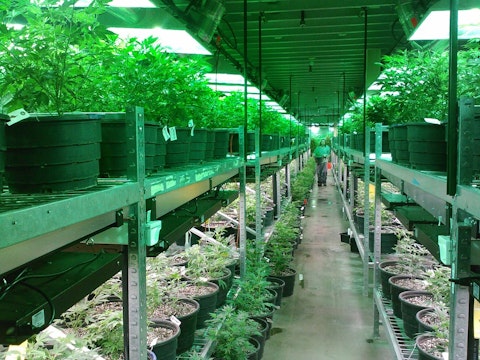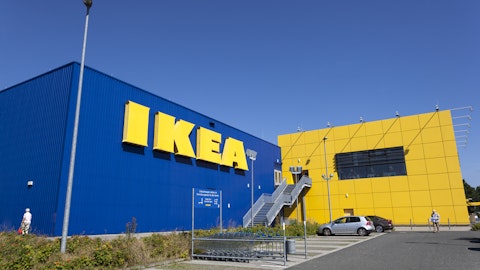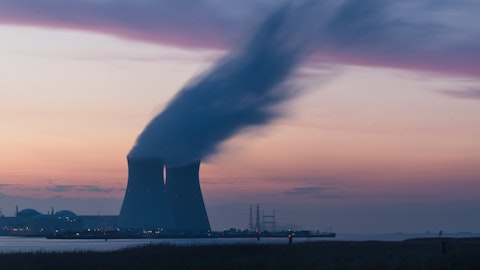In this article, we are going to discuss the 15 U.S. cities with the highest weed consumption in 2023. You can skip our detailed analysis of the cannabis industry in the U.S., the issues faced by the American cannabis industry, and cannabis industry consolidation, and go directly to 5 U.S. Cities with the Highest Weed Consumption in 2023.
The history of the cannabis industry is riddled with changes and conflicting legislation. The international media has played an important role in shifting perspectives about marijuana and drug use. Today, we are watching the slow and steady change of mainstream opinion to consider cannabis one of the more harmless – and probably even potentially beneficial – drugs still considered largely illegal. As perspectives change, we can expect the laws to eventually follow suit.
Cannabis Industry in the U.S.:
The U.S. legal cannabis industry took some hits in 2022, but according to top cannabis researcher Brightfield Group, annual revenue of the industry is estimated to reach $31.8 billion by the end of 2023, growing to $50.7 billion by 2028. The increasing legalization of cannabis and rising acceptance of its use for medical purposes are the key factors driving the growth of the market.
Growth is also expected to come from new states. In the first two months of 2023, three states have begun cannabis sales: two adult-use (Connecticut and Maryland) and one medical (Mississippi).
Issues Faced by the Cannabis Industry:
One of the biggest issues faced by the American cannabis industry is federal illegality, which makes the cost of doing business for weed companies higher than any other business. Due to the difference in federal and state marijuana laws, cannabis companies cannot receive traditional banking or loans. They also don’t have bankruptcy protections like traditional businesses so when these companies falter, receivership is one of their few options. Similarly, insurance comes with sky-high costs as well.
Another big barrier to making money is the enormous amount of taxes weed companies pay because they’re treated like illegal narcotics traffickers under the federal tax code. The goods also cannot cross state lines, and that lack of interstate commerce means companies must build separate farms, factories and stores in each state where they do business and navigate a rapidly evolving patchwork of state regulations.
Lastly, the constantly narrowing gap between supply and demand has caused prices to nosedive. Retail and wholesale prices have also fallen as competition with the black market puts pressure on legal retailers to keep prices low. The retail price of a gram of marijuana dropped 13% to $9.43 in Q3 of 2022 from $10.83 in the same period the previous year – the steepest fall ever seen for marijuana in a 1-year period.
One of the companies that has faced the brunt of these issues is Hydrofarm Holdings Group, Inc. (NASDAQ:HYFM), a maker of hydroponic plant growing supplies and equipment. Stock price of Hydrofarm Holdings Group, Inc. (NASDAQ:HYFM) has plunged a staggering 74.3% since August 2022 after the company reported a loss of over $285 million in its last financial year. When a company doesn’t make profit, we’d generally expect to see good revenue growth, but Hydrofarm Holdings Group, Inc. (NASDAQ:HYFM) also saw its revenue fall by 28%.
Similarly, Ontario-based Canopy Growth Corporation (NASDAQ:CGC) was the largest cannabis company in the world in April 2019, but the stock price of the company has fallen by nearly 90% since December 2022. The market cap of Canopy Growth Corporation (NASDAQ:CGC) has slumped from nearly $19 billion in 2021 to $325.6 million today. Shares of Canopy Growth Corporation (NASDAQ:CGC) dropped by 40% on the 14th of July after the company announced it was issuing new shares to reduce its debt load, just one day before a key debt maturity.
It’s high time that the federal and state governments take this industry seriously and start providing some of the resources other industries take for granted.
Cannabis Industry Consolidation:
With the market continuing to mature and evolve, companies are gearing up for a wave of consolidation to navigate an increasingly challenging business climate in which to operate. Financial pressures and regulatory complexity have been contributing factors to the development of this trend, as well as the incessant need to improve customer experiences and broaden e-commerce applications.
One of the blockbuster deals in recent years was the $2.4 billion acquisition of Aphria by Tilray Brands, Inc. (NASDAQ:TLRY) in 2021. Tilray Brands, Inc. (NASDAQ:TLRY) also recently completed the $56 million acquisition of Hexo, after shareholders of the company approved the deal on June 14th 2023. According to Tilray Brands, Inc. (NASDAQ:TLRY), the acquisition solidifies its top market-share position in Canadian cannabis. Headquartered in New York, Tilray Brands, Inc. (NASDAQ:TLRY) ranks among the Biggest Marijuana Companies in the World.
With that said, here are the U.S. Cities Consuming the Most Weed in 2023.

Methodology:
To collect data for this article, we have referred to the 2023 Cannabis Price Index by the CFAH, looking for the American Cities with the Highest Weed Consumption in 2023. To keep our list relevant, we have only selected larger cities with populations of 200,000 or more. When two cities had the same consumption of weed, we ranked them by their cannabis industry revenue instead.
If you’re also interested in investing in the weed industry, here are the 11 Best Marijuana Stocks to Buy Now.
15. Washington D.C.
Total Weed Consumption: 2 metric tons
In November 2014, District voters approved the Legalization of Possession of Minimal Amounts of Marijuana for Personal Use initiative. The law became effective in February 2015, and as a result, it is legal for a person who is at least 21 years old to possess 2 ounces or less of marijuana.
While recreational marijuana is legal in the city – albeit with restrictions – it remains against the law on federal land. There are seven medical dispensaries and eight cultivators licensed in D.C.
14. Albuquerque, NM
Total Weed Consumption: 3 metric tons
Gov. Michelle Lujan Grisham announced in April that the state of New Mexico saw $300 million in adult-use cannabis sales in its first year, which began in April 2022. In one year, the state has issued 2,000 cannabis licenses across New Mexico, including 633 cannabis retailers, 351 producers, 451 micro producers and 507 manufacturers.
As of March 2023, more than $27 million in cannabis excise taxes has gone to the state general fund and to local communities.
13. Detroit, MI
Total Weed Consumption: 3 metric tons
Cannabis sales in Michigan hit record highs last year, with companies profiting more than $221 million in the month of December alone, according to a state report. However, as the industry continues to boom, some companies are beginning to fall behind.
Skymint – one of the biggest producers in Michigan – entered into receivership in March after defaulting on a $127 million loan. This is the fifth cannabis company in the Great Lake State to recently enter into receivership. A nearly 90% price drop in wholesale cannabis prices over the last 2 years also made making money challenging for some cannabis companies.
12. Boston, MA
Total Weed Consumption: 3.6 metric tons
The legal marijuana industry in Massachusetts is showing signs of maturing. In five years since the first recreational dispensary in the state opened in Northampton in 2018, gross sales of non-medical marijuana in Massachusetts hit $4 billion. In just the first five months of 2023, gross sales totaled $600 million.
But prices have plummeted. An ounce of marijuana flower sells for $171, according to the state’s Cannabis Control Commission. As recently as two years ago, the price was $400 per ounce. With some of the best dispensaries in the country, Boston ranks among the cities that consume the most weed in America.
11. Lincoln, NE
Total Weed Consumption: 3.7 metric tons
The state of Nebraska has decriminalized possession of small amounts of cannabis, punishing possession of up to one ounce with a $300 citation, but the sale of any amount of marijuana is still a felony.
That does not stop in-state residents from crossing into Colorado and other western states, where it is legal, to bring back cannabis products.
10. Las Vegas, NV
Total Weed Consumption: 4.1 metric tons
Legal marijuana consumption comes with some obvious problems sometimes but the Las Vegas strip has an extra issue that’s raising concerns. Casino operators, including the Sin City’s biggest operators Caesars Entertainment, Inc. (NASDAQ:CZR) and MGM Resorts International (NYSE:MGM) can’t play any part in the cannabis industry.
Since they’re regulated by federal law, casino operators can’t house any dispensaries or Las Vegas’ newly-approved cannabis lounges. That forces people into cars and that’s creating fears as fatal car crashes have been on the rise in Nevada.
9. Seattle, WA
Total Weed Consumption: 4.6 metric tons
Seattle Mayor Bruce Harrell signed three ordinances last year aimed at improving equity and helping people of color break into the state’s mostly white legal cannabis industry.
Washington state collected a total of $515.2 million in legal marijuana income and license fees in fiscal year 2022. Seattle ranks among the top 10 U.S. cities with the highest weed consumption in 2023.
8. Portland, OR
Total Weed Consumption: 5 metric tons
At $7 per gram, marijuana prices in Portland are lower than they’ve ever been because the market is saturated with product and the demand isn’t growing.
Portland Community College is now offering cannabis programs to students who want to pursue a career in the marijuana industry upon graduation. Since the inception of Oregon’s legal cannabis market in 2015, it has become an almost $1 billion industry.
Portland was declared the ‘Best Weed City’ of 2023, according to a study by Real Estate Witch and Leafly. The Portland Best Buds is among the top 10 dispensaries in the state.
7. Denver, CO
Total Weed Consumption: 6.8 metric tons
Famous for its craft beer scene, Colorado is also home to Ceria Brewing Co., which became a pioneer of marijuana infused beverages when it debuted its first THC beer in 2018. But right now, the company’s offerings are not available in its home state because it no longer has a local partner licensed to package the THC beer. Because laws prohibit marijuana from crossing state lines, products sold in Colorado must also be manufactured there. Colorado is among the states where weed is the most legal in the U.S.
6. Philadelphia, PA
Total Weed Consumption: 10.6 metric tons
Philadelphia decriminalized the possession and use of marijuana in 2014, which means that although weed is not legal in Philly, small amounts have been decriminalized and you won’t be arrested for minor offenses. Philadelphia ranks 6th in our list of Top Weed Consuming Cities in the U.S. in 2023.
Click to continue reading and see the 5 U.S. Cities with the Highest Weed Consumption in 2023.
Suggested Articles:
- Top 20 Countries with the Highest Percentage of Smokers
- 30 Drunkest Cities in America in 2023
- 16 Most Valuable Cigarette Brands
Disclosure: None. 15 U.S. Cities with the Highest Weed Consumption in 2023 is originally published on Insider Monkey.





